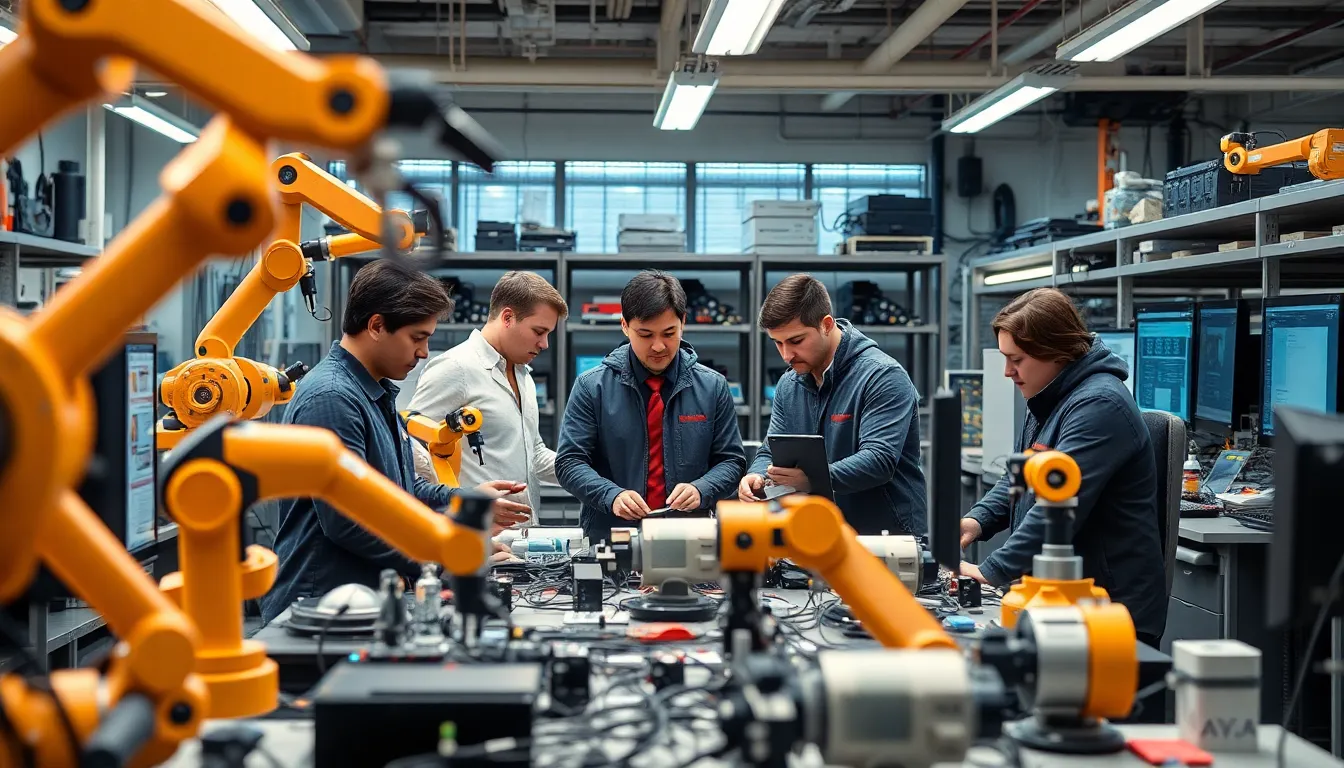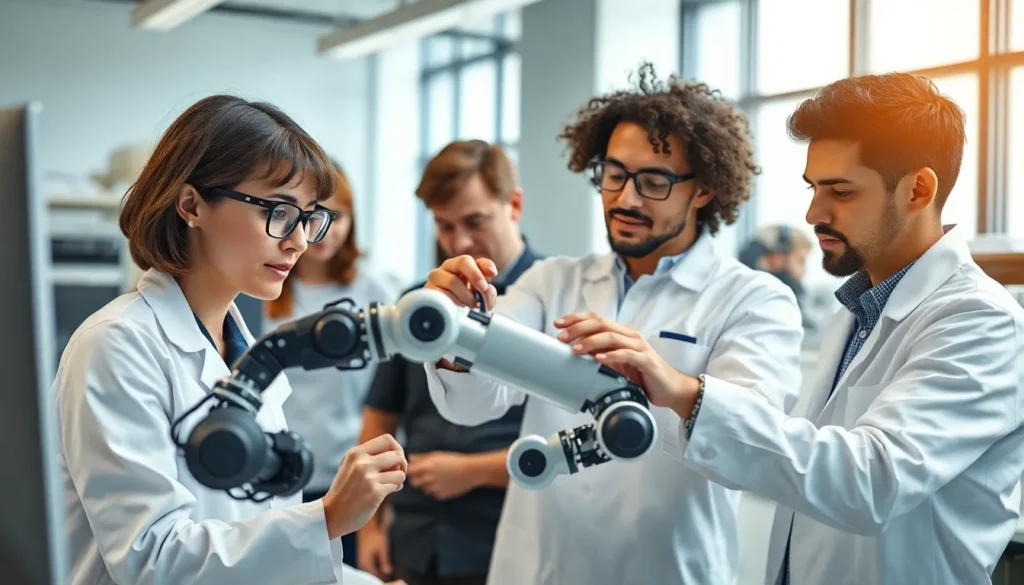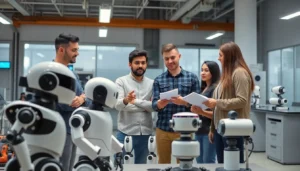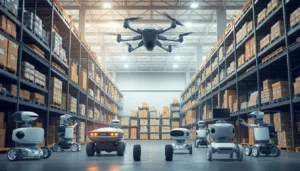In today’s fast-paced world, robotics and AI innovations are transforming industries and reshaping everyday life. From autonomous vehicles to intelligent personal assistants, these technologies are no longer just concepts of the future; they’re integral parts of our present. As advancements continue to accelerate, the potential for increased efficiency and creativity becomes limitless.
Businesses are leveraging robotics and AI to streamline operations, enhance productivity, and deliver personalized experiences. This fusion of technology not only drives economic growth but also raises intriguing questions about the future of work and human interaction. Understanding these innovations is crucial for anyone looking to navigate the evolving landscape of technology and its impact on society.
Table of Contents
ToggleOverview of Robotics and AI Innovations
Robotics and AI innovations encompass a broad range of technologies that enhance efficiency and automate processes across various sectors. Recent advancements include robotic automation in manufacturing, where robots handle tasks like assembly and quality control. These robots operate with high precision, significantly reducing errors and increasing production speed.
Intelligent algorithms empower AI systems to analyze vast data sets, leading to improved decision-making in industries such as healthcare and finance. For example, AI-driven diagnostic tools assist medical professionals in identifying conditions faster and with greater accuracy. In finance, AI algorithms analyze market trends to predict fluctuations, supporting investment strategies.
Drones and autonomous vehicles represent another facet of these innovations. Drones facilitate delivery services and agricultural monitoring, enhancing logistics and resource management. Autonomous vehicles promise safer transportation solutions, relying on advanced sensors and machine learning to navigate complex environments.
AI-powered chatbots improve customer service by providing instant support and personalized interactions. Businesses leverage these tools to enhance customer experiences while reducing operational costs.
These innovations raise critical questions about workforce dynamics and ethical considerations. As machines perform tasks traditionally done by humans, the potential for job displacement increases. Balancing technological advancement with societal needs remains a key challenge as these trends continue to evolve.
Key Technologies Driving Robotics and AI

Robotics and AI are propelled by several key technologies that enhance functionality and efficiency. These advancements significantly transform industrial processes and daily conveniences.
Machine Learning in Robotics
Machine learning significantly enhances robotics by enabling robots to learn from data and improve their performance over time. Algorithms analyze patterns in data, allowing robots to adapt to new tasks without explicit reprogramming. For example, robotic arms in manufacturing can adjust their movements based on past experiences, optimizing assembly line efficiency. Additionally, reinforcement learning techniques enable robots to make decisions in unpredictable environments, such as in autonomous vehicles navigating traffic situations in real-time.
Advanced Sensors and Control Systems
Advanced sensors and control systems provide critical input for robotics and AI applications. Sensors capture rich data about the environment, including visual, auditory, and tactile information. For instance, LIDAR and cameras allow autonomous vehicles to detect obstacles, while pressure sensors in robotic hands provide feedback for delicate tasks. Control systems process this data and execute precise movements, ensuring robots perform tasks with high accuracy. By integrating advanced sensors and control systems, industries improve automation capabilities and enhance operational safety across various sectors.
Applications of Robotics and AI Innovations
Robotics and AI innovations are transforming multiple sectors, offering enhanced efficiency and new solutions. The advancements in these technologies lead to significant improvements in various applications.
Healthcare Robotics
Healthcare robotics enhances patient care and operational efficiency in medical facilities. Surgical robots perform intricate procedures with precision, reducing recovery times and improving patient outcomes. Telepresence robots enable remote consultations, allowing healthcare professionals to connect with patients in rural or underserved areas. Rehabilitation robots aid in physical therapy by providing targeted exercises and real-time feedback. AI-driven diagnostic tools analyze medical images and patient data to assist doctors in early disease detection and personalized treatment plans.
Autonomous Vehicles
Autonomous vehicles play a critical role in revolutionizing transportation and logistics. Self-driving cars utilize sensors, cameras, and AI algorithms to navigate roads, enhancing safety by minimizing human error. In logistics, drones and automated delivery vehicles streamline supply chains, efficiently delivering packages to various locations. Ride-sharing services leveraging self-driving technology reduce traffic congestion and promote sustainable transportation. Continuous advancements in AI and robotics drive the development of smarter, safer systems for various transportation applications.
Challenges and Ethical Considerations
Challenges and ethical considerations significantly impact the deployment of robotics and AI innovations. Addressing job displacement and privacy concerns remains crucial as these technologies advance.
Job Displacement Concerns
Job displacement concerns arise as robotics and AI technologies automate tasks traditionally handled by human workers. Industries such as manufacturing, logistics, and customer service report an increasing reliance on automation, leading to job losses in specific sectors. For example, research from the World Economic Forum indicates that automation may displace about 85 million jobs by 2025, while also creating 97 million new roles in technology and skilled trades. The workforce must adapt through reskilling and upskilling programs to prepare for the evolving job landscape, although not all workers will have equal access to these opportunities. The challenge lies in ensuring a supportive transition for displaced employees, which may require collaboration between governments, educational institutions, and businesses to create effective training programs.
Privacy and Security Issues
Privacy and security issues complicate the growth of robotics and AI technologies. Data collection practices often raise concerns about user consent and the potential for misuse. For instance, AI systems powering surveillance technologies can infringe on individuals’ privacy rights, leading to a growing demand for stringent regulations. A report by the Electronic Frontier Foundation highlights the risks associated with widespread data collection, emphasizing the need for clear privacy policies and transparent data usage practices. Furthermore, security vulnerabilities in AI systems can lead to harmful consequences, such as unauthorized access and data breaches. Addressing these aspects requires a robust framework to ensure ethical data management and security protocols that protect users and maintain public trust in emerging technologies.
Future Trends in Robotics and AI
Robotics and AI innovations will transform workplaces and daily life in the coming years. Key trends include enhanced collaboration between humans and robots, expansion of AI capabilities, and the rise of ethical considerations in technology deployment.
- Human-Robot Collaboration: Collaborative robots, or cobots, enhance human tasks by working alongside people in shared environments. Cobots optimize workflow in sectors like manufacturing and healthcare, increasing safety and productivity.
- Advanced AI Capabilities: AI systems will evolve with improvements in machine learning, natural language processing, and computer vision. These advancements enable more sophisticated applications, such as real-time language translation and personalized medicine tailored to individual patient needs.
- AI in Automation: Widespread adoption of AI-driven automation will streamline operations across industries. Robotic process automation (RPA) improves efficiency in tasks such as data entry and analytics, freeing employees to focus on strategic initiatives.
- Robotics in Everyday Life: The integration of robotics in personal and household applications will grow. Domestic robots capable of performing chores such as cleaning and cooking enhance convenience and improve quality of life.
- AI Ethics and Governance: As AI technologies become ubiquitous, ethical considerations regarding data privacy, algorithmic transparency, and bias will gain prominence. Governments and organizations will develop frameworks to ensure responsible AI usage.
- AI and Robotics in Education: Educational institutions will increasingly incorporate AI and robotics into curricula, fostering skills development for future jobs in technology. Learning through robotics kits and AI-driven tutoring systems prepares students for evolving job markets.
- Improved HMI (Human-Machine Interfaces): Innovations in user interfaces will facilitate more intuitive interactions between humans and machines. Gesture control, voice recognition, and neural interfaces simplify communication with robots and AI systems.
- Sustainability through Robotics: Robotics solutions targeting environmental challenges will emerge. Drones and automated systems play crucial roles in monitoring natural resources, optimizing agricultural practices, and managing waste.
- Healthcare Innovations: Robotics and AI will advance healthcare efficiencies by improving diagnostics, treatment accuracy, and patient monitoring. Deploying AI-driven robots in surgery and rehabilitation enhances care quality and accessibility.
- Regulation and Policy Development: As technology continues to evolve, regulatory frameworks will adapt to address challenges associated with AI and robotics. Ensuring compliance with emerging standards will be essential for businesses deploying these technologies.
Understanding these emerging trends enables stakeholders to navigate the landscape of robotics and AI effectively, preparing for the profound changes that lie ahead.
Robotics and AI innovations are reshaping industries and daily life in profound ways. As these technologies continue to evolve they promise to enhance efficiency and improve quality of life. Yet they also bring challenges that require careful consideration.
The balance between leveraging advancements and addressing ethical concerns is crucial for a sustainable future. Preparing the workforce through education and reskilling initiatives will be essential as job dynamics shift.
Ultimately the journey of integrating robotics and AI into society will demand collaboration among various stakeholders to ensure that technological progress aligns with human values and needs.










